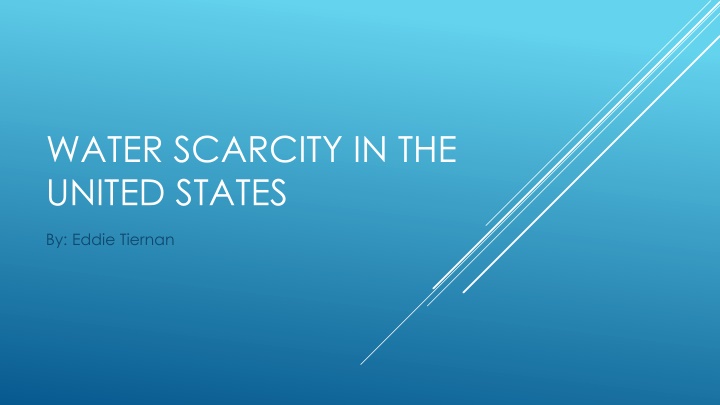
Water Scarcity in the United States Analysis
This study delves into the issue of water scarcity in the United States, examining various factors such as population growth, precipitation patterns, land cover changes, and the Falkenmark Indicator. Through a time-dependent analysis, the research aims to determine the critical year when water scarcity will become a significant concern in different states. Population trends and environmental parameters are crucial in predicting future water availability and usage trends. The findings shed light on the challenges facing the US in ensuring water security for its residents.
Download Presentation

Please find below an Image/Link to download the presentation.
The content on the website is provided AS IS for your information and personal use only. It may not be sold, licensed, or shared on other websites without obtaining consent from the author. If you encounter any issues during the download, it is possible that the publisher has removed the file from their server.
You are allowed to download the files provided on this website for personal or commercial use, subject to the condition that they are used lawfully. All files are the property of their respective owners.
The content on the website is provided AS IS for your information and personal use only. It may not be sold, licensed, or shared on other websites without obtaining consent from the author.
E N D
Presentation Transcript
WATER SCARCITY IN THE UNITED STATES By: Eddie Tiernan
INSPIRATION AND INTRODUCTION 1989 Malin Falkenmark presents Falkenmark Indicator ??? FI = ??????????, Water Scarcity 1000 ??????/?????? 2015 Paul Ruess analyzed current global water stress Objective Determine the year water scarcity is reached for each of the United States
TIME DEPENDENT FI Land Cover(t) (Curve Number) Mean Annual Runoff Falkenmark Indicator Precipitation (t) Population(t)
TIME DEPENDENT FI Land Cover(t) (Curve Number) Mean Annual Runoff Falkenmark Indicator Precipitation (t) Population(t) 1
TIME DEPENDENT FI Land Cover(t) (Curve Number) Mean Annual Runoff Falkenmark Indicator Precipitation (t) 2 Population(t) 1
TIME DEPENDENT FI Land Cover(t) (Curve Number) Mean Annual Runoff 3 Falkenmark Indicator Precipitation (t) 2 Population(t) 1
POPULATION(T) Pennsylvania Alabama 12,820,000 4870000.00 4860000.00 12,800,000 4850000.00 12,780,000 4840000.00 Population Population 4830000.00 12,760,000 y = 51,151.40ln(x) + 12,712,212.18 R = 1.00 4820000.00 y = 14,841.23x + 4,771,102.53 R = 1.00 12,740,000 4810000.00 4800000.00 12,720,000 4790000.00 12,700,000 4780000.00 0 1 2 3 4 5 6 7 0 1 2 3 4 5 6 7 Years Beyond 2009 Years Beyond 2009 Florida 20,400,000 20,200,000 20,000,000 19,800,000 Population y = 18,557,770.15e0.01x R = 0.99 19,600,000 19,400,000 19,200,000 19,000,000 18,800,000 18,600,000 0 1 2 3 4 5 6 7 Years Since 2009
LAND COVER(T) SCS CURVE NUMBER ??? = ???? ??= ???? (? 0.2 ?)2 ?+0.8 ? 1000 ?? 10 ? =
LAND COVER(T) NLCD 2001, 06, 11 WA OR ID NV UT CA CO VA KS OK AZ NM TX
CURVE NUMBER Virginia Curve Number vs Year Texas Curve Number vs Year 68 73.9 y = 0.04x - 12.497 R = 0.9967 67.95 y = 0.024x + 25.573 R = 0.9977 State Averaged Curve Number 73.85 67.9 73.8 67.85 Curve Number 67.8 73.75 67.75 73.7 67.7 67.65 73.65 67.6 73.6 67.55 67.5 73.55 2000 2002 2004 2006 Year 2008 2010 2012 2000 2002 2004 2006 Year 2008 2010 2012
???? (?(?) 0.2 ?(?))2 ?(?) + 0.8 ?(?) ??????????(?) ??(?) =
YEARS TO WATER SCARCITY Western States Falkenmark Indicator vs Year 45000 40000 35000 FI (m^3/year/capita) 30000 25000 20000 15000 10000 5000 0 2005 2010 2015 2020 2025 2030 Year 2035 2040 2045 2050 2055 Water Scarcity California Utah Arizona Nevada Texas Virginia Colorado Washington Idaho Kansas New Mexico Oklahoma Oregon
THREAT OF WATER SCARCITY WA OR ID NV UT CO VA CA KS AZ OK NM TX
THREAT OF WATER SCARCITY COMPARISON TO PAUL RUESS
REFERENCES Ruess, P. (2015). Mapping of Water Stress Indicators. CE 394K Term Paper. Posa, R. (2015). Development and Land Use Change in the Central Potomac River Watershed. CE 394K Term Paper. Mackun, P., Wilson, S. (2011). Population Distribution and Change: 2000 to 2010. US Census Bureau. Falkenmark, M. (1989). The massive water scarcity now threatening Africa: why isn't it being addressed? Ambio, 112-118. Kirtman, B., Power S., Adedoyin J.A., Boer G.J., et al. (2013). Near-term Climate Change: Projections and Predictability. In: Climate Change 2013: The Physical Science Basis. Contribution of Working Group I to the Fifth Assessment Report of the Intergovernmental Panel on Climate Change. Cambridge University Press, Cambridge, United Kingdom and New York, NY, USA. Mays, L. (2011). Water Resources Engineering. Hoboken, NJ: John Wiley & Sons. National Land Cover Data. Obtained from www.usgs.gov U.S. Census Data. Obtained from www.census.gov Proposal of the President (2015). Adoption of the Paris Agreement. Framework Convention on Climate Change. United Nations. Average Annual Precipitation by State. Current Results: Weather and Science Facts. Obtained from https://www.curren0tresults.com/Weather/US/average-annual-state-precipitation.php
